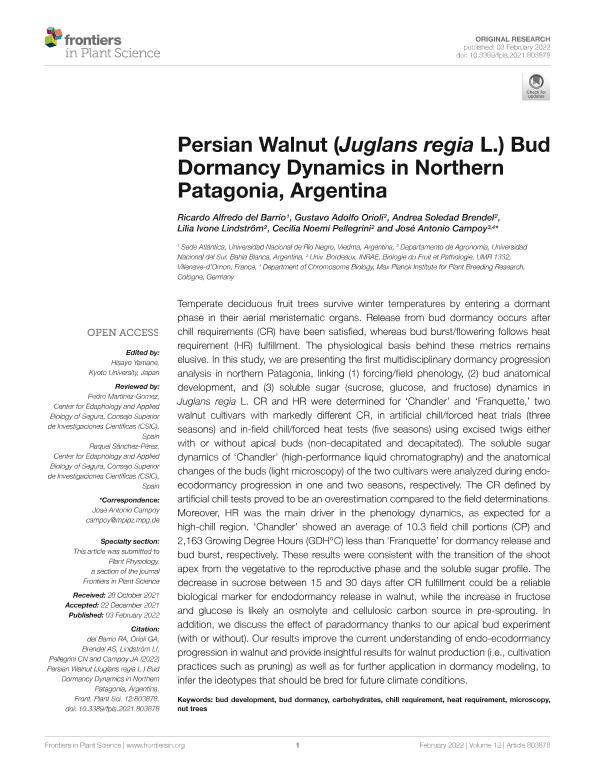Mostrar el registro sencillo del ítem
dc.contributor.author
del Barrio, Ricardo Alfredo

dc.contributor.author
Orioli, Gustavo Adolfo

dc.contributor.author
Brendel, Andrea Soledad

dc.contributor.author
Lindström, Lilia Ivone

dc.contributor.author
Pellegrini, Cecilia

dc.contributor.author
Campoy, José Antonio
dc.date.available
2023-07-14T14:18:35Z
dc.date.issued
2022-02-03
dc.identifier.citation
del Barrio, Ricardo Alfredo; Orioli, Gustavo Adolfo; Brendel, Andrea Soledad; Lindström, Lilia Ivone; Pellegrini, Cecilia; et al.; Persian Walnut (Juglans regia L.) Bud Dormancy Dynamics in Northern Patagonia, Argentina; Frontiers Media; Frontiers in Plant Science; 12; 3-2-2022; 1 - 20
dc.identifier.issn
1664-462X
dc.identifier.uri
http://hdl.handle.net/11336/203957
dc.description.abstract
Temperate deciduous fruit trees survive winter temperatures by entering a dormant phase in their aerial meristematic organs. Release from bud dormancy occurs after chill requirements (CR) have been satisfied, whereas bud burst/flowering follows heat requirement (HR) fulfillment. The physiological basis behind these metrics remains elusive. In this study, we are presenting the first multidisciplinary dormancy progression analysis in northern Patagonia, linking (1) forcing/field phenology, (2) bud anatomical development, and (3) soluble sugar (sucrose, glucose, and fructose) dynamics in Juglans regia L. CR and HR were determined for ‘Chandler’ and ‘Franquette,’ two walnut cultivars with markedly different CR, in artificial chill/forced heat trials (three seasons) and in-field chill/forced heat tests (five seasons) using excised twigs either with or without apical buds (non-decapitated and decapitated). The soluble sugar dynamics of ‘Chandler’ (high-performance liquid chromatography) and the anatomical changes of the buds (light microscopy) of the two cultivars were analyzed during endo-ecodormancy progression in one and two seasons, respectively. The CR defined by artificial chill tests proved to be an overestimation compared to the field determinations. Moreover, HR was the main driver in the phenology dynamics, as expected for a high-chill region. ‘Chandler’ showed an average of 10.3 field chill portions (CP) and 2,163 Growing Degree Hours (GDH°C) less than ‘Franquette’ for dormancy release and bud burst, respectively. These results were consistent with the transition of the shoot apex from the vegetative to the reproductive phase and the soluble sugar profile. The decrease in sucrose between 15 and 30 days after CR fulfillment could be a reliable biological marker for endodormancy release in walnut, while the increase in fructose and glucose is likely an osmolyte and cellulosic carbon source in pre-sprouting. In addition, we discuss the effect of paradormancy thanks to our apical bud experiment (with or without). Our results improve the current understanding of endo-ecodormancy progression in walnut and provide insightful results for walnut production (i.e., cultivation practices such as pruning) as well as for further application in dormancy modeling, to infer the ideotypes that should be bred for future climate conditions.
dc.format
application/pdf
dc.language.iso
eng
dc.publisher
Frontiers Media

dc.rights
info:eu-repo/semantics/openAccess
dc.rights.uri
https://creativecommons.org/licenses/by/2.5/ar/
dc.subject
BUD DEVELOPMENT
dc.subject
BUD DORMANCY
dc.subject
CARBOHYDRATES
dc.subject
CHILL REQUIREMENT
dc.subject
HEAT REQUIREMENT
dc.subject
MICROSCOPY
dc.subject
NUT TREES
dc.subject.classification
Horticultura, Viticultura

dc.subject.classification
Agricultura, Silvicultura y Pesca

dc.subject.classification
CIENCIAS AGRÍCOLAS

dc.title
Persian Walnut (Juglans regia L.) Bud Dormancy Dynamics in Northern Patagonia, Argentina
dc.type
info:eu-repo/semantics/article
dc.type
info:ar-repo/semantics/artículo
dc.type
info:eu-repo/semantics/publishedVersion
dc.date.updated
2023-07-05T12:41:51Z
dc.journal.volume
12
dc.journal.pagination
1 - 20
dc.journal.pais
Suiza

dc.journal.ciudad
Lausana
dc.description.fil
Fil: del Barrio, Ricardo Alfredo. Universidad Nacional de Río Negro. Sede Andina; Argentina
dc.description.fil
Fil: Orioli, Gustavo Adolfo. Universidad Nacional del Sur. Departamento de Agronomía; Argentina. Consejo Nacional de Investigaciones Científicas y Técnicas; Argentina
dc.description.fil
Fil: Brendel, Andrea Soledad. Consejo Nacional de Investigaciones Científicas y Técnicas. Centro Científico Tecnológico Conicet - Bahía Blanca. Instituto Argentino de Oceanografía. Universidad Nacional del Sur. Instituto Argentino de Oceanografía; Argentina. Universidad Nacional del Sur. Departamento de Agronomía; Argentina
dc.description.fil
Fil: Lindström, Lilia Ivone. Universidad Nacional del Sur. Departamento de Agronomía; Argentina
dc.description.fil
Fil: Pellegrini, Cecilia. Universidad Nacional del Sur. Departamento de Agronomía; Argentina
dc.description.fil
Fil: Campoy, José Antonio. Max Planck Institute Of Biochemistry.; Alemania
dc.journal.title
Frontiers in Plant Science
dc.relation.alternativeid
info:eu-repo/semantics/altIdentifier/url/https://www.frontiersin.org/articles/10.3389/fpls.2021.803878/full
dc.relation.alternativeid
info:eu-repo/semantics/altIdentifier/doi/https://doi.org/10.3389/fpls.2021.803878
Archivos asociados
